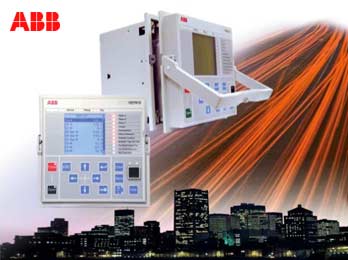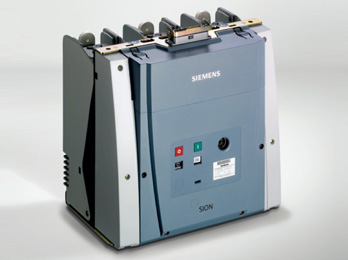9,916 views

ABB Feeder Protection REF615 ANSI
The REF615 is powerful, most advanced and simplest feeder protection relay in its class, perfectly offering time and instantaneous overcurrent, negative sequence overcurrent, phase discontinuity, breaker failure and thermal overload protection. The relay also features optional high impedance fault (HIZ) and sensitive earth fault (SEF) protection for grounded and ungrounded distribution systems. Also, the relay incorporates a flexible three-phase multi-shot auto-reclose function for automatic feeder restoration in temporary faults on overhead lines. Enhanced with safety options, the relay offers a three-channel arc-fault detection system for supervision of the switchgear circuit breaker, cable and busbar compartments.
The REF615 also integrates basic control functionality, which facilitates the control of one circuit breaker via the relay’s front panel human machine interface (HMI) or remote control system. To protect the relay from unauthorized access and to maintain the integrity of information, the relay has been provided with a four-level, role-based user authentication system, with individual passwords for the viewer, operator, engineer and administrator level. The access control system applies to the front panel HMI, embedded web browser based HMI and the PCM600 relay setting and configuration tool.
Standardized communication
REF615 supports the new IEC 61850 standard for inter-device communication in substations. The relay also supports the industry standard DNP3.0 and Modbus® protocols.
The implementation of the IEC 61850 substation communication standard in REF615 encompasses both vertical and horizontal communication, including GOOSE messaging and parameter setting according to IEC 61850-8-1. The substation configuration language enables the use of engineering tools for automated configuration, commissioning and maintenance of substation devices.
Bus protection via GOOSE
The REF615 IEC 61850 implementation includes GOOSE messaging for fast horizontal relay-to-relay communication. Applying GOOSE communication to the REF615 relays of the incoming and outgoing feeders of a substation, a stable, reliable and high-speed bus protection system can be realized. The cost-effective GOOSE-based bus protection is obtained just by configuring the relays and the operational availability of the protection is assured by continuous supervision of the protection relays and their GOOSE messaging over the station communication network.
Costs are reduced since no separate physical input and output hard-wiring is needed for horizontal communication between the relays.

Bus protection via GOOSE
Pre-emptive condition monitoring
For continuous knowledge of the operational availability of the REF615 features, a comprehensive set of monitoring functions to supervise the relay health, the trip circuit and the circuit breaker health is included. The breaker monitoring can include checking the wear and tear of the circuit breaker, the spring charging time of the breaker operating mechanism and the gas pressure of the breaker chambers. The relay also monitors the breaker travel time and the number of circuit breaker (CB) operations to provide basic information for scheduling CB maintenance.
Rapid set-up and commissioning
Due to the ready-made adaptation of REF615 for the protection of feeders, the relay can be rapidly set up and commissioned, once it has been given the application- specific relay settings. If the relay needs to be adapted to the special requirements of the intended application, the flexibility of the relay allows the relay’s standard signal configuration to be adjusted by means of the signal matrix tool (SMT) included in its PCM600 relay setting and configuration user tool.
By means of Connectivity Packages containing complete descriptions of ABB’s protection relays, with data signals, parameters and addresses, the relays can be automatically configured via PCM600 relay setting and configuration user tool, COM600 Station Automation series devices, or MicroSCADA Pro substation automation system.
Unique draw-out design relay
The draw-out type relay design speeds up installation and testing of the protection. The factory-tested relay units can be withdrawn from the relay cases during factory and commissioning tests. The relay case provides automatic short-circuiting of the CT secondary circuits to prevent hazardous voltages from arising in the CT circuits when a relay plug-in unit is withdrawn from its case.
The pull-out handle locking the relay unit into its case can be sealed to prevent the unit from being unintentionally withdrawn from the relay case.
REF615 highlights
- Comprehensive overcurrent protection with high impedance fault, sensitive earth fault and thermal overload protection for feeder and dedicated protection schemes
- Simultaneous DN3.0 Level 2+ and Modbus Ethernet communications plus device connectivity and system interoperability according to the IEC 61850 standard for next generation substation communication
- Enhanced digital fault recorder functionality including high sampling frequency, extended length of records, 4 analog and 64 binary channels and flexible triggering possibilities
- High-speed, three-channel arc flash detection (AFD) for increased personal safety, reduced material damage and minimized system down-time
- Total control of the operational capability of the protection system through extensive condition monitoring of the relay and the associated primary equipment
- Draw-out type relay unit and a unique relay case design for a variety of mounting methods and fast installation, routine testing and maintenance
- One single tool for managing relay settings, signal configuration and disturbance handling
Analog inputs
- Three phase currents: 5/1 A
- Ground current: 5/1 A or 0.2 A
- Rated frequency: 60/50 Hz programmable
Binary inputs and outputs
- Four binary inputs with common ground
- Two NO double-pole outputs with TCM
- Two NO single-pole outputs
- One Form C signal output
- One Form C self-check alarm output
- Additional seven binary inputs plus three binary outputs (available as an option)
Communication
- IEC 61850-8-1 with GOOSE messaging
- DNP3.0 Level 2+ over TCP/IP
- Modbus over TCP/IP
- Time synchronization via SNTP (primary and backup servers)
- Optional serial RS-485 port programmable for DNP3.0 Level 2+ or Modbus RTU
Control voltage
- Option 1: 48 … 250 V dc, 100 … 240 V ac
- Option 2: 24 … 60 V dc
.
SOURCE: ABB
.
Related articles
3,807 views

Siemens technical publication | Loss Of Vacuum
If a vacuum interrupter should lose vacuum, several operating situations should be considered:
1. With contacts open
2. When closing
3. When closed and operating normally
4. When opening and interrupting normal current
5. When opening and interrupting a fault.
Cases 1, 2 and 3 are relatively straightforward. Generally, the system sees no impact from loss of vacuum in such a situation. Cases 4 and 5, however, require further discussion. Suppose there is a feeder circuit breaker with a vacuum interrupter on phase 3 that has lost vacuum. If the load being served by the failed interrupter is a deltaconnected (ungrounded) load, a switching operation would not result in a failure. Essentially, nothing would happen. The two good phases (phase 1 and phase 2, in this example) would be able to clear the circuit, and current in the failed interrupter (phase 3) would cease.
The alternative case of a grounded load is a different situation. In this case, interruption in the two good phases (phase 1 and phase 2) would not cause current to stop flowing in phase 3, and the arc would continue to exist in phase 3. With nothing to stop it, this current would continue until some backup protection operated. The result, of course, would be destruction of the interrupter.
Since the predominant usage of circuit breakers in the 5-15 kV range is on grounded circuits, we investigated the impact of a failed interrupter some years ago in the test lab. We intentionally caused an interrupter to lose vacuum by opening the tube to the atmosphere. We then subjected the circuit breaker to a full short circuit interruption. As predicted,
the “flat” interrupter did not successfully clear the affected phase, and the “flat” interrupter was destroyed. The laboratory backup breaker cleared the fault. Following the test, the circuit breaker was removed from the switchgear cell. It was very sooty, but mechanically intact. The soot was cleaned from the circuit breaker and the switchgear cell, the faulty interrupter was replaced, and the circuit breaker was re-inserted in the cell. Further short circuit interruption tests were conducted the same day on the circuit breaker.
Field experience in the years since that test was conducted supports the information gained in the laboratory experiment. One of our customers, a large chemical operation, encountered separate failures (one with an air magnetic circuit breaker and one with a vacuum circuit breaker) on a particular circuit configuration. Two different installations, in different countries, were involved. They shared a common circuit configuration and failure mode. The circuit configuration, a tie circuit in which the sources on each side of the circuit
breaker were not in synchronism, imposed approximately double rated voltage across the contact gap, which caused the circuit breaker to fail. Since these failures resulted from application in violation of the guidelines of the ANSI standards, and greatly in excess of the design ratings of the circuit breakers, they are not indicative of a design
problem with the equipment.
However, the damage that resulted from the failures is of interest. In the case of the air magnetic circuit breaker, the unit housing the failed circuit breaker was destroyed, and the adjacent switchgear units on either side were damaged extensively, requiring significant rebuilding. The air magnetic circuit breaker was a total loss. In the case of the vacuum circuit breaker, the failure was considerably less violent. The vacuum interrupters were replaced, and the arc by-products (soot) cleaned from both the circuit breaker and the compartment. The unit was put back into service. Our test experience in the laboratory, where we routinely explore the limits of interrupter performance, also supports these results.
More recently, several tests were performed in our high-power test laboratory to compare the results of attempted interruptions with “leaky” vacuum interrupters. A small hole (approximately 1/8” diameter) was drilled in the interrupter housing, to simulate a vacuum interrupter that had lost vacuum.
The results of these tests were very interesting:
- One pole of a vacuum circuit breaker was subjected to an attempted interruption of 1310 A (rated continuous current = 1250 A). The current was allowed to flow in the “failed” interrupter for 2.06 seconds, at which point the laboratory breaker interrupted. No parts of the “failed” circuit breaker or the interrupter flew off, nor did the circuit breaker explode. The paint on the exterior of the interrupter arcing chamber peeled off. The remainder of the circuit breaker was undamaged.
. - A second pole of the same vacuum circuit breaker was subjected to an attempted interruption of 25 kA (rated interrupting current = 25 kA), for an arc-duration of 0.60 seconds, with the laboratory breaker interrupting the current at that time. The arc burned a hole in the side of the arc chamber. The circuit breaker did not explode, nor did parts of the circuit breaker fly off. Glowing particles were ejected from the hole in the arcing chamber. None of the mechanical components or other interrupters were damaged. Essentially, all damage was confined to the failed interrupter.
Our experience suggests rather strongly that the effects of a vacuum interrupter failure on the equipment are very minor, compared to the impact of failures with alternative interruption technologies. But the real question is not what the results of a failure might be, but rather, what is the likelihood of a failure? The failure rate of Siemens vacuum interrupters is so low that loss of vacuum is no longer a significant concern. In the early 1960s with early vacuum interrupters, it was a big problem. A vacuum interrupter is constructed with all connections between dissimilar materials made by brazing or welding. No organic materials are used. In the early years, many hand-production techniques were used, especially when borosilicate glass was used for the insulating envelope, as it could not tolerate high temperatures. Today, machine welding and batch induction furnace brazing are employed with extremely tight process control. The only moving part inside the interrupter is the copper contact, which is connected to the interrupter end plate with a welded stainless steel bellows. Since the bellows is welded to both the contact and the interrupter end plate, the failure rate of this moving connection is extremely low. This accounts for the
extremely high reliability of Siemens vacuum interrupters today.
In fact, the MTTF (mean time to failure) of Siemens power vacuum interrupters has now reached 24,000 years (as of October 1991). Questions raised by customers regarding loss of vacuum were legitimate concerns in the 1960s, when the use of vacuum interrupters for power applications was in its infancy. At that time, vacuum interrupters suffered from frequent leaks, and surges were a problem. There was only one firm that offered vacuum circuit breakers then, and reports suggest that they had many problems. We entered the vacuum circuit breaker market in 1974, using Allis-Chalmers’ technology and copper-bismuth contact materials. In the early 1980′s, after becoming part of the worldwide Siemens organization, we were able to convert our vacuum designs to use Siemens vacuum interrupters, which had been introduced in Europe in the mid-1970s. Thus, when we adopted the Siemens vacuum interrupters in the U.S., they already had a very well established field performance record.
The principle conceptual differences in the modern Siemens vacuum interrupters from the early 1960s designs lies in contact material and process control. Surge phenomena are more difficult to deal with when copper-bismuth contacts are used than with today’s chromecopper contacts. Similarly, leaks were harder to control with vacuum interrupters built largely by hand than with today’s units. Today, great attention is paid to process control and elimination of the human factor (variability) in manufacture. The result is that the Siemens vacuum interrupters today can be expected to have a long service life and to impose dielectric stress on load equipment that is not significantly different from the stresses associated with traditional air magnetic or oil circuit breakers.
.
Published by: SIEMENS AG
.





